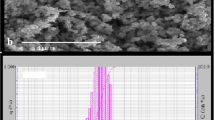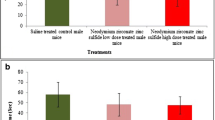Abstract
Zinc oxide nanoparticles (ZnO NPs) have diverse utility these days ranging from being part of nanosensors to be ingredient of cosmetics. Present study was designed to report the effect of variable doses of ZnO NPs on selected aspects of male albino mice behavior. Nano particles were synthesized by sol-gel auto-combustion method (Data not shown here). 10 week old male albino mice were divided into four experimental groups; group A, B and C were orally supplemented with 50 (low dose), 300 (medium dose) and 600 mg/ml solvent/kg body weight (high dose) of ZnO NPs for 4 days. Group D (control) orally received 0.2 M sodium phosphate buffer (solvent for ZnO NPs) for the same duration. A series of neurological tests (Rota rod, open field, novel object and light–dark box test) were conducted in all groups and performance was compared between ZnO NPs treated and control group. Muscular functioning during rota rod test was significantly improved in all ZnO NPs treated mice as compared to control group. While no significant differences in open field, novel object and light–dark box test performance were observed when data from studied parameters of specific ZnO NPs treatment were compared with the control group indicating that applied doses of ZnO NPs did not affect the exploratory, anxiolytic behavior and object recognition capability of adult male albino mice.

Similar content being viewed by others
References
Sarkar S, Makhal A, Baruah S, Mahmood MA, Dutta J, Pal SK (2012) Nanoparticle-sensitized photodegradation of bilirubin and potential therapeutic application. J Phys Chem C 116:9608–9615
Radzimska AK, Jesionowski T (2014) Zinc oxide—from synthesis to application: a review. Materials 7:2833–2888
Zhang H, Ji Z, Xia T, Meng H, Low-Kam C, Liu R, Pokhrel S, Lin S, Wang X, Liao Y-P (2012) Use of metal oxide nanoparticle band gap to develop a predictive paradigm for oxidative stress and acute pulmonary inflammation. ACS Nano 6:4349–4368
Chang Y-N, Zhang M, Xia L, Zhang J, Xing G (2012) The toxic effects and mechanisms of CuO and ZnO nanoparticles. Materials 5:2850–2871
Bondarenko O, Juganson K, Ivask A, Kasemets K, Mortimer M, Kahru A (2013) Toxicity of Ag, CuO and ZnO nanoparticles to selected environmentally relevant test organisms and mammalian cells in vitro: a critical review. Arch Toxicol 87:1181–1200
Khan YA, Singh BR, Ullah R, Shoeb M, Naqvi AH, Abidi SM (2015) Anthelmintic effect of biocompatible zinc oxide nanoparticles (ZnO NPs) on gigantocotyle explanatum, a neglected parasite of Indian water buffalo. PloS One 10:e0133086
Silvestro RAD (2004) Handbook of minerals as nutritional supplements, CRC Press
Hennigar SR, Kelleher SL (2012) Zinc networks: the cell-specific compartmentalization of zinc for specialized functions. Biol Chem 393(7):565–578
Hsieh CW, Tu ME, Wu YH (2010) Allergic contact dermatitis induced by zinc pyrithione in shampoo: a case report. Dermatologica Sinica 28:163–166
Liu H, Yang D, Yang H, Zhang H, Zhang W, Fang Y, Liu Z, Tian L, Lin B, Yan J (2013) Comparative study of respiratory tract immune toxicity induced by three sterilization nanoparticles: silver, zinc oxide and titanium oxide. J Hazard Mat 248:478–486
Mirhosseini M, Firouzabadi F (2012) Antibacterial activity of zinc oxide nanoparticle suspensions on food-borne pathogens. Int J Dairy Technol 65:1–5
Mason P (2006) Physiological and medicinal zinc. Pharm J 276:271–274
Vandebriel RJ, De Jong WH (2012) A review of mammalian toxicity of ZnO nanoparticles. Nanotech Sci App 5:61–71
Tian L, Bencheng L, Lei W, Kang L, Huanliang L, Jun Y, Xiohua L (2015) Neurotoxicity induced by zinc oxide nanoparticles: age-related differences and interaction. Scientific Reports 5:16117
Zhao J, Xu L, Zhang T, Ren G, Yang Z (2009) Influences of nanoparticle zinc oxide on acutely isolated rat hippocampal CA3 pyramidal neurons. Neurotoxicology 30(2):220–230
Allahyar R, Akbar A, Iqbal F (2016) Effect of creatine monohydrate supplementation on learning, memory and neuromuscular coordination in female albino mice. Acta Neuropsychiatrica. doi:10.1017/neu.2016.28
Iqbal S, Ali M, Iqbal F (2015) Long term creatine monohydrate supplementation, following neonatal hypoxic ischemic insult, improves neuromuscular coordination and spatial learning in male albino mouse. Brain Res 1603:76–83
Zhang R, Xue G, Wang S, Zhang L, Shi C, Xie X (2012) Novel object recognition as a facile behavior test for evaluating drug effects in AβPP/PS1 Alzheimer’s disease mouse model. J Alzheimers Dis 31:801–812
Zahra K, Khan M, Iqbal F (2015) Oral supplementation of Ocimum basilicum has the potential to improves the locomotory, exploratory, anxiolytic behavior and learning in adult male albino mice. Neurol Sci 36:73–78
Xia T, Kovochich M, Liong M, Mädler L, Gilbert B, Shi H, Yeh JI, Zink JI, Nel AE (2008) Comparison of the mechanism of toxicity of zinc oxide and cerium oxide nanoparticles based on dissolution and oxidative stress properties. ACS Nano 2:2121–2134
Vandebriel RJ, De Jong WH (2012) A review of mammalian toxicity of ZnO nanoparticles. Nanotech Sci App 5:61
Zahra J, Iqbal S, Latif M, Ali M, Shad MA, Tabish TH, Ashiq MN, Iqbal F (2016) A note on the Biocompatibility of Zinc oxide Nanoparticles in male albino mice. Nanosci Nanotech Lett (in press)
Tabish MT, Ashiq MN, Ullah MA, Iqbal S, Latif M, Ehsan MF, Iqbal F (2016) Biocompatibility of cobalt iron oxide magnetic nanoparticles in male rabbit. Korean J Chem Eng 33(7):2222–2227
Deng X, Luan Q, Chen W, Wang Y, Wu M, Zhang H, Jiao Z (2009) Nanosized zinc oxide particles induce neural stem cell apoptosis. Nanotechnology 20:115101
Xie Y, Wang Y, Zhang T, Ren G, Yang Z (2012) Effects of nanoparticle zinc oxide on spatial cognition and synaptic plasticity in mice with depressive-like behaviors. J Biomed Sci 19:14
Wang B, Feng W, Wang M, Wang T, Gu Y, Zhu M, Ouyang H, Shi J, Zhang F, Zhao Y (2008) Acute toxicological impact of nano-and submicro-scaled zinc oxide powder on healthy adult mice. J Nanopart Res 10:263–276
Amara S, Slama IB, Omri K, Ghoul JE, Mir LE, Rhouma KB, Abdelmelek H, Sakly M (2015) Effects of nanoparticle zinc oxide on emotional behavior and trace elements homeostasis in rat brain. Toxicol Ind Health 31:1202–1209
Dadong H, Yutao T, Tao Z, Guogang E, Zhuo Y (2011) Nano-zinc oxide damages spatial cognition capability via over-enhanced long-term potentiation in hippocampus of Wistar rats. Int J Nanomed 6:1453–1461
Reddy KM, Feris K, Bell J, Wingett DG, Hanley C, Punnoose A (2007) Selective toxicity of zinc oxide nanoparticles to prokaryotic and eukaryotic systems. Applied physics letters 90:213902
Franklin NM, Rogers NJ, Apte SC, Batley GE, Gadd GE, Casey PS (2007) Comparative toxicity of nanoparticulate ZnO, bulk ZnO, and ZnCl2 to a freshwater microalga (Pseudokirchneriella subcapitata): the importance of particle solubility. Environ Sci Technol 41:8484–8490
Heinlaan M, Ivask A, Blinova I, Dubourguier H-C, Kahru A (2008) Toxicity of nanosized and bulk ZnO, CuO and TiO 2 to bacteria Vibrio fischeri and crustaceans Daphnia magna and Thamnocephalus platyurus. Chemosphere 71:1308–1316
Author information
Authors and Affiliations
Corresponding authors
Ethics declarations
Conflict of interest
Authors declare that they have no conflict of interest of any sort with anyone.
Additional information
Javeria Zahra and Shahid Iqbal have contributed equally to the manuscript.
Electronic supplementary material
Below is the link to the electronic supplementary material.

Rights and permissions
About this article
Cite this article
Zahra, J., Iqbal, S., Zahra, K. et al. Effect of Variable Doses of Zinc Oxide Nanoparticles on Male Albino Mice Behavior. Neurochem Res 42, 439–445 (2017). https://doi.org/10.1007/s11064-016-2090-y
Received:
Revised:
Accepted:
Published:
Issue Date:
DOI: https://doi.org/10.1007/s11064-016-2090-y




